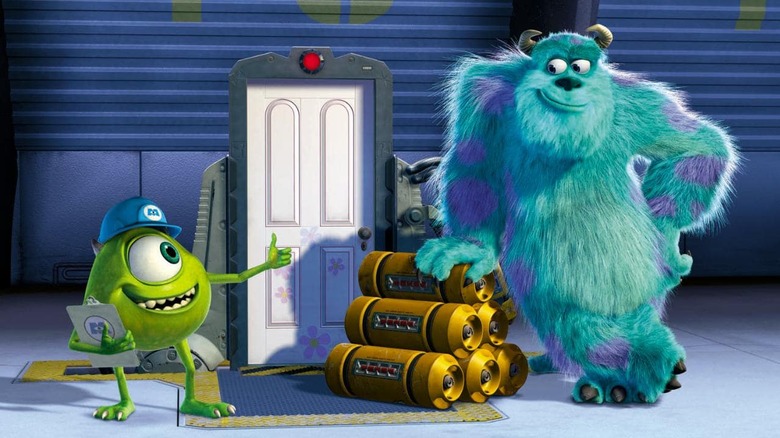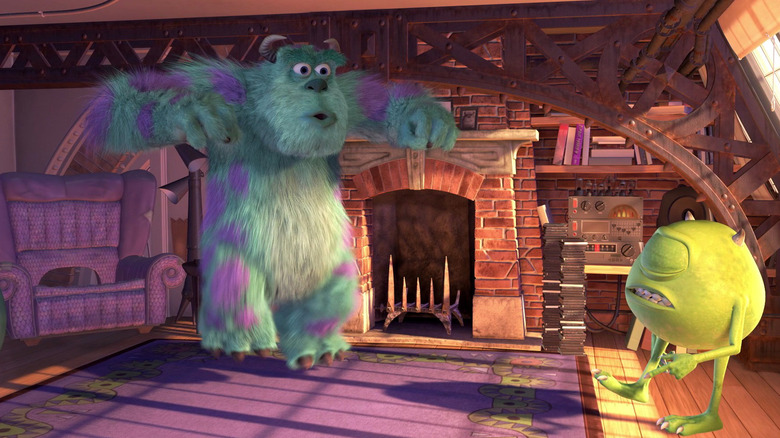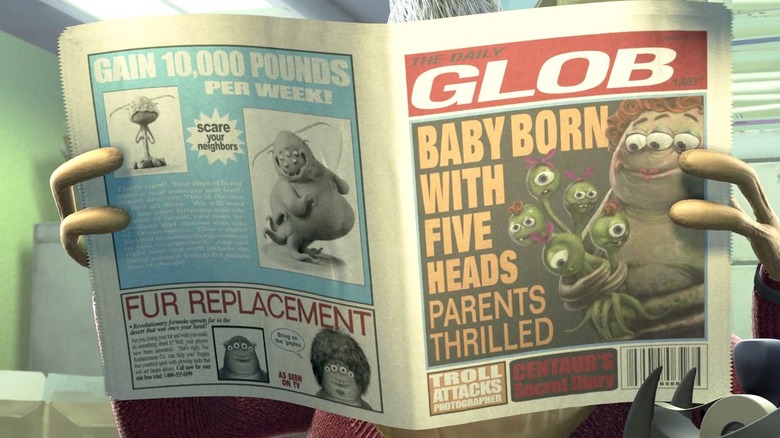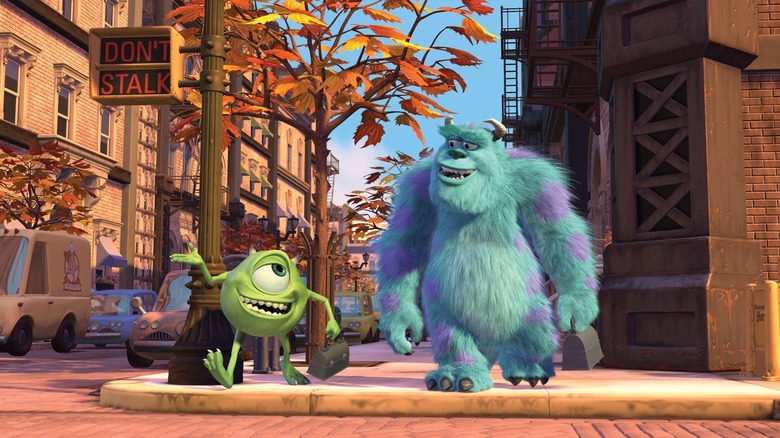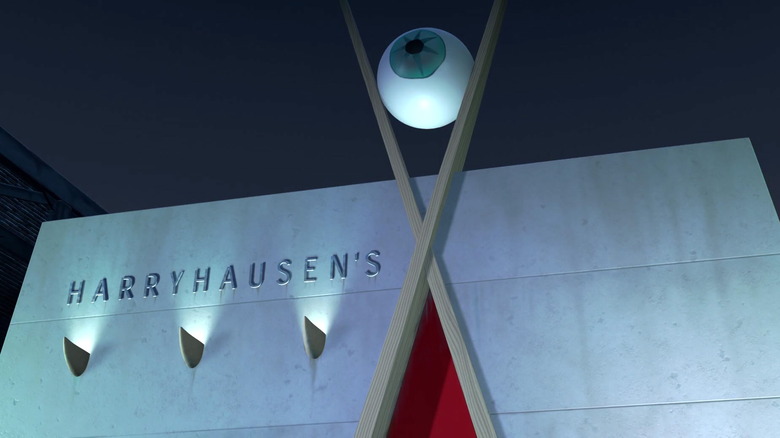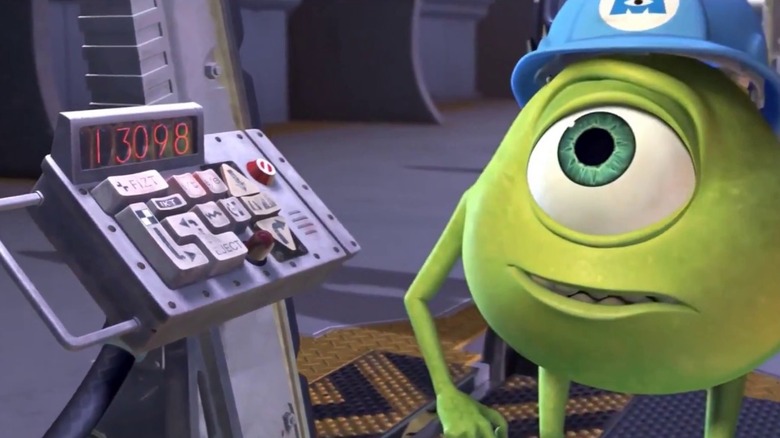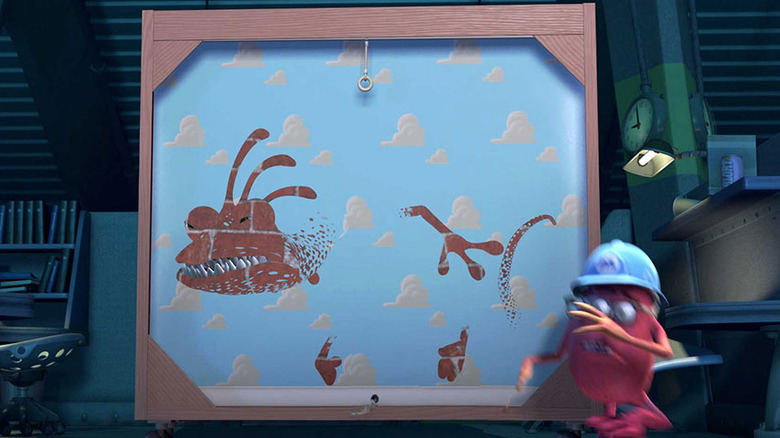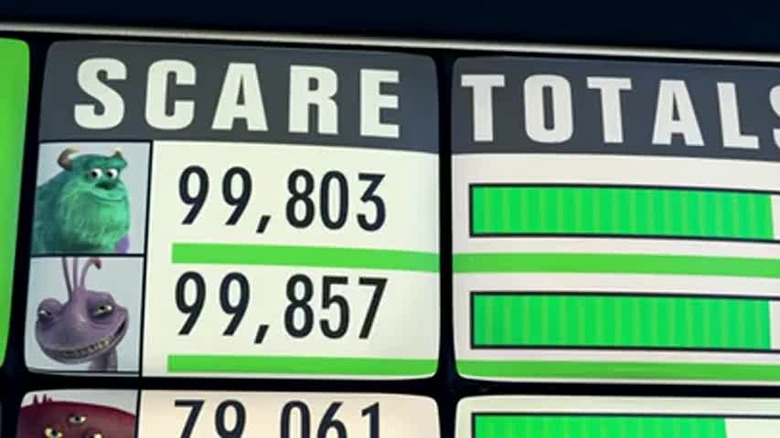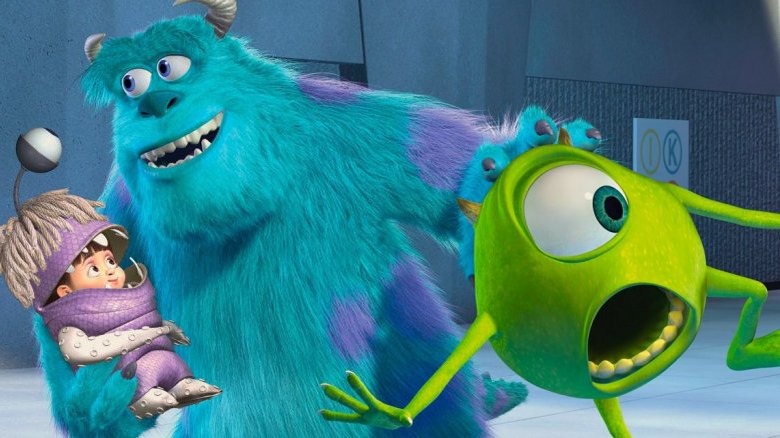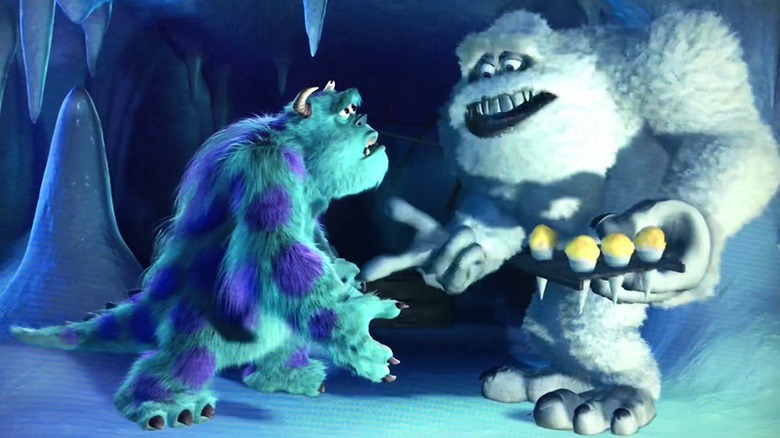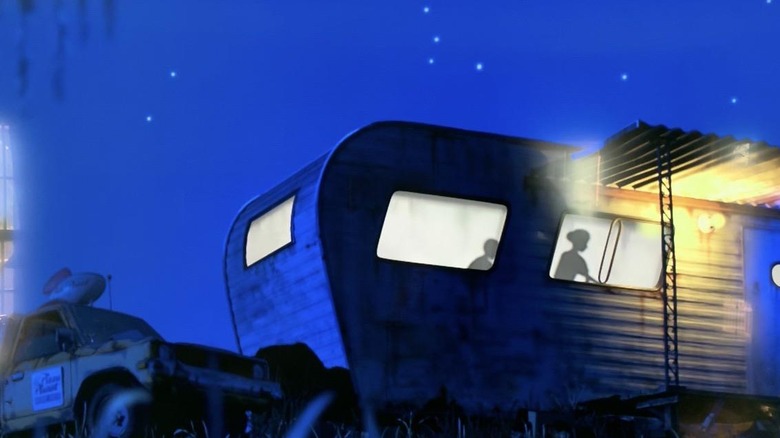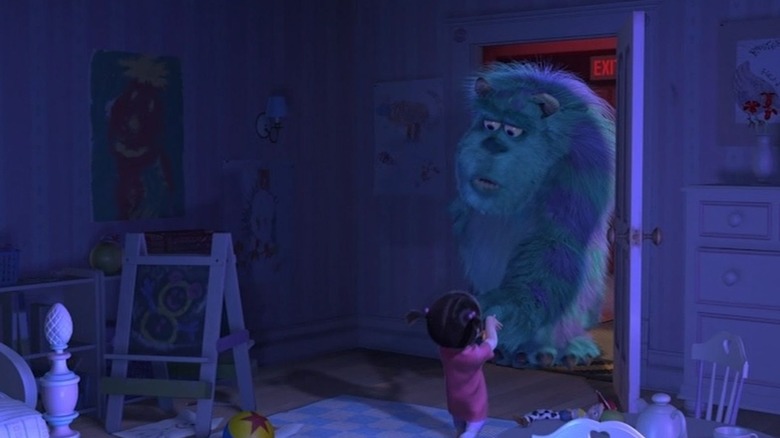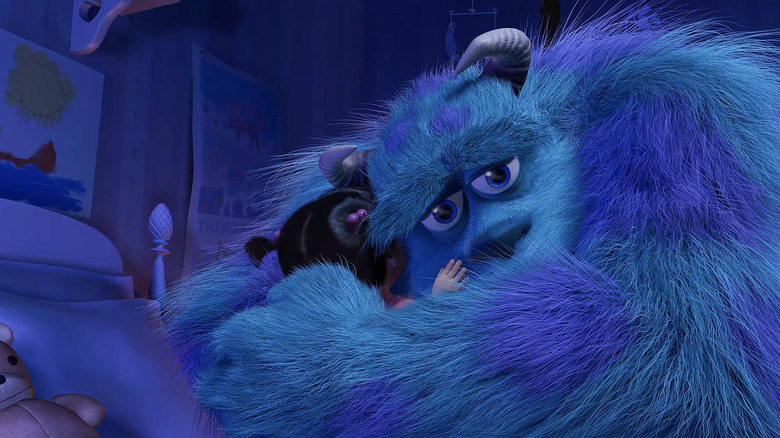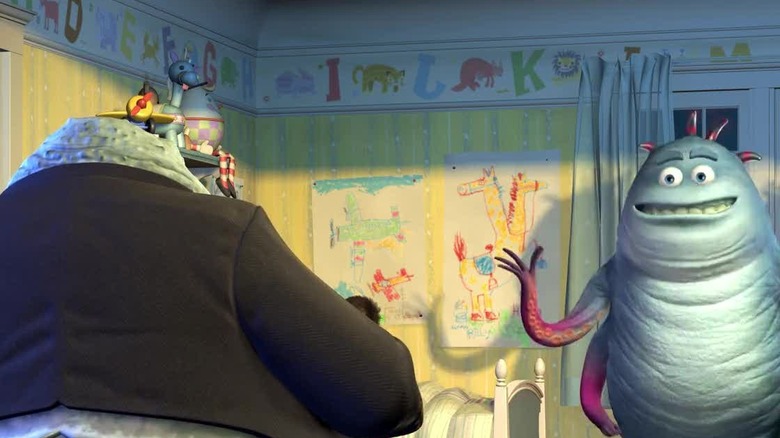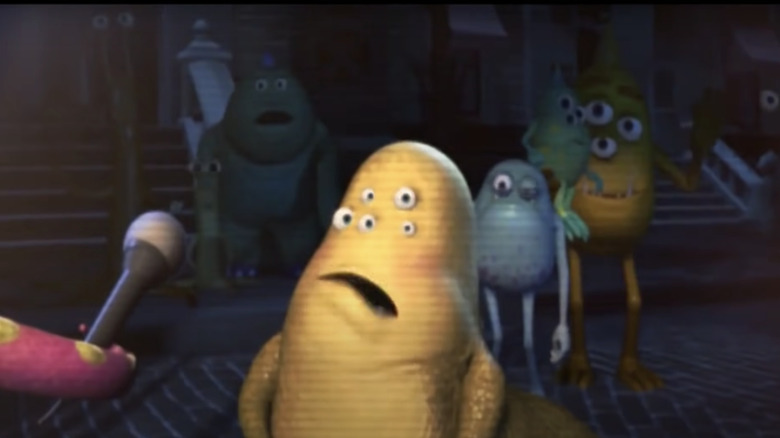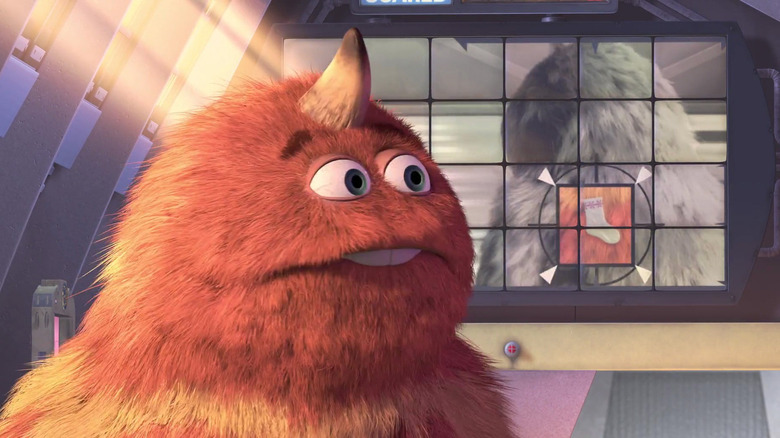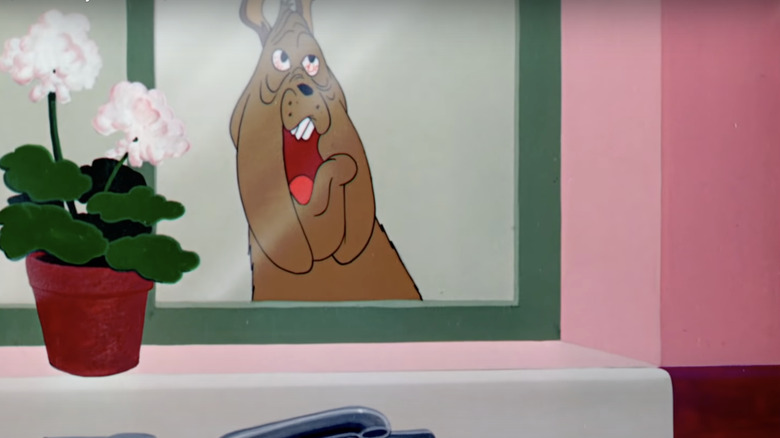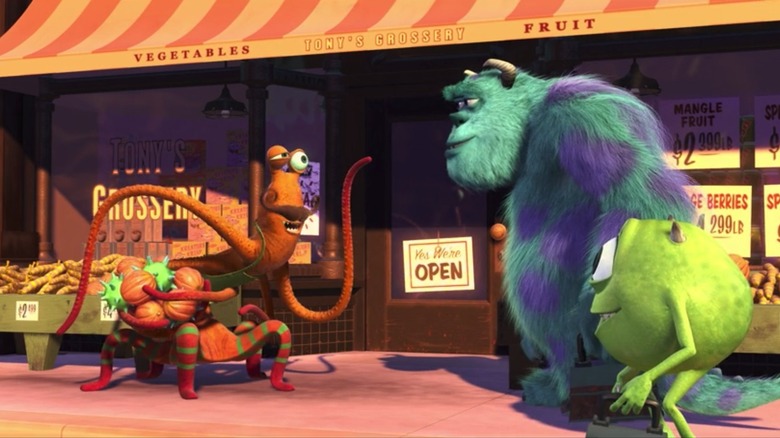Things Only Adults Notice In Monsters, Inc.
Pixar cemented its reputation for genius with 2001's Monsters, Inc., its fourth film following Toy Story, Toy Story 2, and A Bug's Life. The story of two monsters, a lost little girl, and too many doors to count hasn't dimmed in the years since its premiere: Monsters, Inc. has brought laughter, tears, and more than a few scares to countless kids and adults around the world. No wonder Pixar revisited Mike, Sulley, and all the other denizens of the monster world in 2013's Monsters University.
So much time has passed since the movie's initial release that those who first saw it at Boo's age are now full-fledged adults. If you're one of those fans, you might find yourself spotting a few new details here and there throughout the film. Grown-ups and kids might agree on Monsters, Inc.'s greatness, but there's a whole lot of the movie that goes over the latter group's head. Get ready for rousing chorus of "Put That Thing Back Where It Came From, or So Help Me," because it's time to take a look at all the things only adults notice in Monsters, Inc.
Mike and Sulley's apartment is full of surprises
After a gorgeously animated opening title sequence and a peek into the world of scare training, we move to the home of the top scarer, James P. Sullivan, better known as Sulley. An early morning training montage ensues, in which Sulley and Mike, his best friend and roommate, exercise, go over scare tactics, and fight off the dangers of plaque in the bathroom.
Take a moment to linger on the details of their apartment with adult eyes, however, and you'll discover a whole new level of world building. Mike and Sulley's apartment is full of cleverly monster-fied real-world items. Check out the speakers and the fireplace — both of them are designed to look like they have fangs. Their door frame sports eyes, making it look like a monster's grimacing face. Beside it sits their television, which has little horns on top. Beneath it all is the rug, sporting a poison-green serpent all around its border. All of it adds up to a cleverly designed and beautifully furnished monster apartment.
Monstropolis' many newspapers and magazines
Like any modern society, the world of Monstropolis is filled with magazines, newspapers, and tabloids that keep citizens well informed on the issues of the day — or at least entertained. But, like with everything in Monsters, Inc., a boatload of care and thought was put into what these artifacts of print media might look like in a monster world.
The local newspaper, the Monstropolis Horn, can be seen early on in the film, evidencing one of the movie's central plot points: The energy crisis catalyzing the events of the story. Roz is later seen reading the Daily Glob, a delightfully decorated tabloid featuring a story on a five-headed baby (cause for celebration in this world), ads for fur replacement, and a look into the "secret diary" of an apparently scandalous centaur. At the end of the film, Mike is thrilled to see his face on the cover of the magazine Business Shriek ... even though they placed the bar code right on top of his face.
Mike and Sulley's walk to work
On their walk to work, Mike and Sulley give us a glimpse of the wonderfully strange world of Monstropolis on a typical weekday morning. The city is a charmingly monster-fied version of an American city: It's a bustling town full of people on their way to work, who all just happen to sport tentacles, multiple eyes, and/or neon-colored fur. Visible amidst the coffee-sipping monsters and creepily creative architecture, one can glimpse some particularly enjoyable Easter eggs.
One of the businesses we get a look at is the Hidden City Cafe. This establishment takes its name from the real-world cafe where top creatives at Pixar developed the stories for A Bug's Life, Monsters, Inc., Finding Nemo, and WALL-E during one truly legendary lunch hour. We also get a peek at Tony's Grossery (get it? Gross-ery?) where some disgustingly delicious foods are being sold, such as spineapple, mangle fruit, spleen beans, bilge beans, and, of course, blood oranges. Just another scarily ordinary day in Monstropolis.
A fancy restaurant with a famous name
It's Celia's birthday, and Mike's got a reservation at Harryhausen's, one of Monstropolis' most renowned restaurants. Not only does it have delicious food and wonderful atmosphere (plus a chef who knows his way around a knife), it also takes its name from one of history's most celebrated filmmakers, who likely served as a major inspiration for Monsters, Inc.
Who is this pioneer of the screen? We're talking about Ray Harryhausen, known for his brilliant, trailblazing work in the world of stop-motion animation. Harryhausen's work can be seen in such epics as Jason and the Argonauts, First Men in the Moon, and Clash of the Titans. His groundbreaking work in bringing monstrous creations to life has inspired countless animators, directors, and artists including Steven Spielberg, James Cameron, George Lucas, and Peter Jackson. Edgar Wright summed it up best: Harryhausen "made [us] believe in monsters." It's only natural, then, that Monstropolis contain a celebrated establishment bearing his name.
Business on the scare floor
As Roz will tell you any day of the week, nothing is more important than filing your paperwork at the end of the day at Monsters, Inc. But what minutiae is covered in those critically important scaring reports? If you hit the pause button when Mike opens up his scare report, you can get a glimpse of the kind of info that each scarer has on their kid. A classic scare report includes basic information on each child (name, age, gender, race, etc), a history section, a notes section, and even a library-style log of what dates the child has been previously scared on.
After you've eyeballed these forms, take a closer look at the keypad attached to each door on the scare floor. Always activated by a unique key card, some of the keys seem strange and indecipherable (what exactly do FIZT and IKT stand for?) while some look a whole lot like buttons on real world machinery. Most notable and essential of all is the giant EJECT button near the bottom. Even in the world of monsters, you can't escape paperwork, safety equipment, or confusingly labeled interfaces.
Randall's backdrops
One of the most terrifying aspects of Randall, the reptilian villain of Monsters, Inc., is his sneaky camouflage powers. He's not just a jerk — he's a jerk who slithers his way through every crevice and hallway of our heroes' workplace. It is this very skill that makes him a celebrated employee — terrifying kids is a whole lot easier when you can blend in with their toys. Randall is obnoxious, but his results make him Mike and Sulley's closest competitor in scaring.
To warm up for a long day of work, Randall and his partner Fungus run through a series of varied backgrounds which Randall must rapidly blend in against. The final background Randall transforms to match is a charming blue sky covered in clouds — the same pattern that lines the walls of Andy's room in Toy Story. Those looking to find inextricable links between Pixar films have some great evidence in this aesthetic choice made by the Pixar animators.
Who's up on the scare board?
Ah, the scare board. That giant screen hanging above the scare floor, reminding everyone how many screams they've obtained and who has the most screams of all. As per usual, the top two slots are taken by Sulley and Randall, engaged in a fight to break the all-time scare record. But you might be wondering who those scarers lurking below them are, and why some of those names might seem familiar.
As the most Pixar-savvy among us have likely already realized, most of these monsters have the same names as many of the artists who work at the famed computer animation studio. The board features names including Ranft (the late Joe Ranft), Luckey (the late Bud Luckey), Rivera (Jonas Rivera), Peterson (the voice of Roz herself, Bob Peterson), and so on. It's another fun way of honoring the many creators who helped bring this classic story to life, even if none of them have a chance of breaking into the top two slots.
Boo's disguise
Once Boo has found her way into the monster world, our heroes must find a way to sneak her into work with them. But as we already know, monsters believe that human children are highly toxic. Even the sight of a human child is cause to alert the Child Detection Agency, or CDA, for short. Mike and Sulley are forced to disguise Boo as a monster herself, to make sure no one realizes they're carting around the monster equivalent of Polonium.
Boo's sneaky disguise is pretty good, considering the bind Mike and Sulley are in: It makes her look like a purple googly-eyed creature with four tentacles in place of human limbs. It's also a master class in DIY creation, cleverly constructed from various elements of Mike and Sulley's home furnishings. The scaly purple skin is fashioned from their armchair, her eyeballs are the bulbs from Mike's desk, her hair is pulled from a stray mop, the scales on her back appear to be binder clips, and her tentacles are made out of some bubble-wrap-esque material. If scaring doesn't end up working out for them, Mike and Sulley certainly shouldn't have an issue breaking into the fashion industry.
The Yeti's cave
After Mike and Sulley stumble into Randall and Waternoose's devious plan to fix Monstropolis' scream shortage through any means necessary, they are exiled to the Himalayas. But they're not alone there, as it turns out — they're in the company of the Abominable Snowman, voiced by Pixar mainstay John Ratzenberger.
Take a peek around the Snowman's cave and you'll see some delightful details that offer a further glimpse into the life of this chilly recluse. Sharp eyes will catch a prominent box of Swedish lingonberry jam, a celebrated staple food you might know from IKEA. There's also a sign from the 30,000 foot mark on Mount Everest, and a heck of a lot of climbing gear. Whatever he's up to in that frozen cave of his, the Abominable Snowman is certainly working to make the most of his winter wonderland. Nordic desserts and mountain climbing are the stuff of a legendary vacation.
A familiar truck in an unfamiliar place
If you watch enough Pixar films, you start to pick up on some familiar Easter eggs that the studio likes to pepper each of their films with. One reference in particular always seems to find its way into their films: The Pizza Planet truck, which made its debut in Toy Story. The studio has proven to be extra sneaky in hiding this familiar vehicle in their films over the years — seriously, some of its appearances are blink-and-you-miss-it affairs. So where is it hiding in the world of Monstropolis?
If you guessed that some kind of monster-fied Pizza Planet exists in the monster world, you're wrong. Rather, the truck appears in our own world, parked right next to the trailer where Randall is sent at the end of the film. This trailer is an Easter egg itself, actually: It's the same trailer located outside the bugs' world in A Bug's Life. Though Randall will forever spend his days trying to avoid being attacked by gator-hating humans, maybe he can try and get some delicious pizza out of the deal, if nothing else.
The toys in Boo's room
As is to be expected with any Pixar feature, the waterworks arrive in full force towards the end of Monsters, Inc. Having restored her to the human world, Sulley is forced to part ways with little Boo. It's a devastatingly emotional scene, punctuated by Randy Newman's gut-wrenching score that refuses to leave a single eye dry. What sort of cruel world tears a two-year-old and her beloved "Kitty" apart?
Through your haze of tears, you might not have noticed all of the Pixar-themed toys that Boo has lying around her room. What's this lucky little girl playing with? Some serious studio memorabilia, including the classic Pixar ball (sometimes known as the "Luxo ball"), a Jessie doll, and a familiar looking clownfish, who would go on to make his screen debut in Pixar's next feature, Finding Nemo. Who knew that Boo was such a Pixar fan? Anyways, back to the tear-jerking emotional climax.
Monsters Inc. is a kids' movie about parenting
In its prime, Pixar carved out a niche by making kids' movies that weren't just good enough to keep the little guys busy for two hours, but that adults could enjoy as well. Part of their secret was knowing which adults would be watching their movies — ones with kids of their own. "The Incredibles," "Finding Nemo," "Up," "Brave," "Inside Out," the "Toy Story" series — they're all about parenthood, either literally or metaphorically. And so is "Monsters Inc," in ways that often hit harder for adults.
At first, Sulley finds a child entering his world horrifying, but as he gets to know Boo, he evolves into a father figure for her. While Mike insists on treating her as "a pet — that could kill me!" Sulley goes through rituals most parents should recognize: Checking the closet for monsters, staying up until Boo goes to sleep, and playing hide and seek. And while Mike just wants to get rid of Boo, Sulley does everything he can to protect her.
This unconventional take on the parent-child relationship is what makes "Monsters Inc." so emotionally moving. Sulley and Boo provide balance to the film's plot shenanigans, and when Sulley has to give her up so she can return to her parents, it's heartbreaking. Even Mike warms up to her by the end, and his goodbye line, "Go ahead, go grow up," will hit anyone who has watched kids grow up in a blink of an eye. And it all pays up in the understated ending, where we leave Sulley and Boo just as they're reunited after an undefined time apart.
The simulation room couldn't quite get humans right
Monsters Inc. might spend a lot of time working with humans, but that doesn't mean they understand them. And if you don't believe us, just take a closer look at the simulation room the company uses to train future scarers. While we don't learn it's a simulation until after Phlegm flunks his test, there are still a few things subtly wrong enough to clue you in. You don't need too sharp an eye to notice the drawing the "kid" has taped to the wall of a two-headed horse. (As far as we know, that could be exactly what horses look like in Monstropolis.)
And if you keep your finger on the pause button, you should be able to spot other holes in the monster's idea of a human bedroom. There's a book lying on the shelf with nothing on the back cover but a bunch of eyeballs — monster kids might be into it, but we have to imagine it'd creep the heck out of the average human child. Monsters Inc. did recognize that little kids' rooms often come with the alphabet lining the walls, but they haven't quite gotten the hang of the alphabet itself — when Phlegm emerges from under the bed, you can see the "J" behind him is backwards.
The crowd waving in the news report
Like most animated kids' movies, "Monsters Inc." is full of broad slapstick and action spectacle. But what makes Pixar stand out is their ability to combine these elements with subtler observational humor, even if it's so subtle it's occasionally easy to miss. For instance, when Sulley accidentally lets Boo loose in downtown Monstropolis, the result is mass chaos, hysterical exaggerations for the news cameras, and a great big ball of electricity when the CDA (Child Detection Agency) step in.
That doesn't mean director Pete Docter can't find little moments of humanity in all the monstrosity, and they're that much more hilarious for the apocalyptic backdrop they play out against. While witnesses are ranting and raving to the press in the foreground, be sure not to miss the background. If you do, you can see monsters waving to the camera, including one dad waving his baby's arm around. In Monstropolis, just as in real life, there's always someone happy just to be on TV, even in the middle of a disaster.
Monsters Inc. finally has an answer to where your missing socks go
"Monsters Inc." provides some unconventional answers to the great mysteries of life. Why are kids scared that monsters are hiding in their closets? Because the monsters are converting their screams into energy. Where did the Abominable Snowman, the Loch Ness Monster, and Bigfoot come from? They were banished from the monster world to ours. But it also has time for the little mysteries: Most importantly, why do socks keep going missing?
One of the movie's most memorable running gags is the chaos that ensues whenever anyone calls in a code 2319 for child contamination. The victim is almost always poor George, and the contaminant is almost always a sock. Occam's Razor states the simplest solution is the likeliest one: You probably lost your sock in the wash or behind your bureau. But where's the fun in that when you could have a complicated answer like "proving" that your missing socks were lost in another dimension and disintegrated by a monster hazmat squad?
The homage to a Looney Tunes classic
As the first animation studio to go all in on CGI, Pixar marked a huge break with everything that came before. But that doesn't mean they aren't also huge fans of everything that came before, and one of the funniest scenes in "Monsters Inc." is, as Pete Docter admits on the audio commentary, a direct recreation of "one of my favorite cartoons."
He's describing "Feed the Kitty," a "Looney Tunes" cartoon from the undisputed master of facial animation, Chuck Jones. The plot's similar enough to "Monsters Inc." that it's easy to see why it was on Docter's mind: A big bulldog named Marc Anthony tries to scare off a tiny kitten, but then takes it home and tries to keep anyone else from finding it. This goes poorly when Marc Anthony dumps the kitten in the flour just as his owner starts making cookies. We see (but Marc Anthony doesn't) that the kitten escapes before the owner can start the blender, and after she gets fed up with Marc Anthony's antics, she throws him out and all he can do is watch helplessly and react hilariously as the dough is rolled out and chopped up.
Meanwhile, in "Monsters Inc.," Sulley hides Boo in the trash just before it's dumped in the compactor. We see that she escapes, but he has to watch from behind glass as the garbage is crushed and chopped up, thinking that she has met a grisly fate. Sulley's reactions are at least as over the top as Marc Anthony's — they both even keel over when the apparent carnage gets to be too much for them.
The recycled models
It's easy to assume that CGI is less work than traditional animation, and to an extent, that's true. But that doesn't mean it's a walk in the park either. Computer animators may not have to redraw every character in every frame, but designing and modeling them is still a long process. So let's be forgiving if they don't restart that process for every background extra and just add some new colors or textures instead. As soon as you start to notice the recycling, though, it's hard to ignore it. The crowd at Harryhausen's looks near-identical to the one at the factory, to start with. The animators seem to have been especially fond of a few monsters in particular. The long-legged critter the scare board identifies as Schmidt appears sitting on the curb on Mike and Sulley's walk to work and again as one of the interviewees after Boo's "rampage."
Rivera, the skinny, tentacled monster is at least as prolific. He hides behind a mustache to play the grocer and changes color from orange to purple to play the waiter at Harryhausen's. And then there's an unnamed model we'll call the three-eyed, one-horned, yellow (sometimes green, sometimes flying) people-eater. Just for starters, he appears as one of the students in the opening simulation, several times in the news report, and a more compact version is in the daycare group Boo wanders into. The pink-and-purple-spotted, blonde-haired monster watching the kids shows up elsewhere too, including in the Monsters Inc. commercial and as a Harryhausen's patron who Boo photobombs. We're starting to wonder if Monstropolis really has enough population to qualify as a metropolis, or if only a couple dozen monsters live in the whole town.
